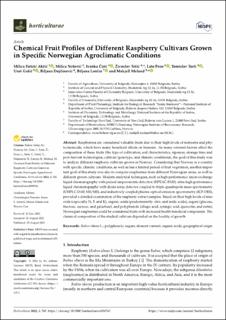Chemical Fruit Profiles of Different Raspberry Cultivars Grown in Specific Norwegian Agroclimatic Conditions
| dc.contributor.author | Akšić, Milica Fotirić | |
| dc.contributor.author | Nešović, Milica | |
| dc.contributor.author | Ćirić, Ivanka | |
| dc.contributor.author | Tešić, Živoslav | |
| dc.contributor.author | Pezo, Lato | |
| dc.contributor.author | Tosti, Tomislav | |
| dc.contributor.author | Gašić, Uroš | |
| dc.contributor.author | Dojčinović, Biljana | |
| dc.contributor.author | Lončar, Biljana | |
| dc.contributor.author | Meland, Mekjell | |
| dc.date.accessioned | 2022-11-21T10:17:20Z | |
| dc.date.available | 2022-11-21T10:17:20Z | |
| dc.date.created | 2022-11-16T12:50:31Z | |
| dc.date.issued | 2022-08-25 | |
| dc.identifier.citation | Horticulturae. 2022, 8 (9), 1-25. | en_US |
| dc.identifier.issn | 2311-7524 | |
| dc.identifier.uri | https://hdl.handle.net/11250/3033097 | |
| dc.description.abstract | Raspberries are considered valuable fruits due to their high levels of nutrients and phytochemicals, which have many beneficial effects on humans. As many external factors affect the composition of these fruits (the type of cultivation, soil characteristics, ripeness, storage time and post-harvest technologies, cultivar/genotype, and climatic conditions), the goal of this study was to analyze different raspberry cultivars grown in Norway. Considering that Norway is a country with specific climatic conditions, as well as has a limited period of fruit vegetation, another important goal of this study was also to compare raspberries from different Norwegian areas, as well as different grown cultivars. Modern analytical techniques, such as high-performance anion-exchange liquid chromatography with pulsed amperometric detection (HPEAC-PAD), ultra-high-performance liquid chromatography with diode array detector coupled to triple quadrupole mass spectrometry (UHPLC-DAD MS/MS), and inductively coupled plasma–optical emission spectrometry (ICP-OES), provided a detailed examination of the raspberry extract samples. Based on their high levels of minerals (especially N, P, and K), organic acids (predominantly citric and malic acids), sugars (glucose, fructose, sucrose, and galactose), and polyphenols (ellagic acid, syringic acid, quercetin, and rutin), Norwegian raspberries could be considered fruits with increased health-beneficial compounds. The chemical composition of the studied cultivars depended on the locality of growth. | en_US |
| dc.language.iso | eng | en_US |
| dc.publisher | MDPI | en_US |
| dc.rights | Navngivelse 4.0 Internasjonal | * |
| dc.rights.uri | http://creativecommons.org/licenses/by/4.0/deed.no | * |
| dc.title | Chemical Fruit Profiles of Different Raspberry Cultivars Grown in Specific Norwegian Agroclimatic Conditions | en_US |
| dc.title.alternative | Chemical Fruit Profiles of Different Raspberry Cultivars Grown in Specific Norwegian Agroclimatic Conditions | en_US |
| dc.type | Peer reviewed | en_US |
| dc.type | Journal article | en_US |
| dc.description.version | publishedVersion | en_US |
| dc.rights.holder | © 2022 by the authors | en_US |
| dc.source.pagenumber | 1-25 | en_US |
| dc.source.volume | 8 | en_US |
| dc.source.journal | Horticulturae | en_US |
| dc.source.issue | 9 | en_US |
| dc.identifier.doi | 10.3390/horticulturae8090765 | |
| dc.identifier.cristin | 2074834 | |
| dc.relation.project | Norges forskningsråd: 280376 | en_US |
| dc.source.articlenumber | 765 | en_US |
| cristin.ispublished | true | |
| cristin.fulltext | original | |
| cristin.qualitycode | 1 |
Tilhørende fil(er)
Denne innførselen finnes i følgende samling(er)
-
Divisjon for matproduksjon og samfunn [1030]
Publikasjoner knyttet til ansatte ved Divisjon for matproduksjon og samfunn -
Publikasjoner fra CRIStin - NIBIO [4575]
-
Vitenskapelige artikler [1416]

